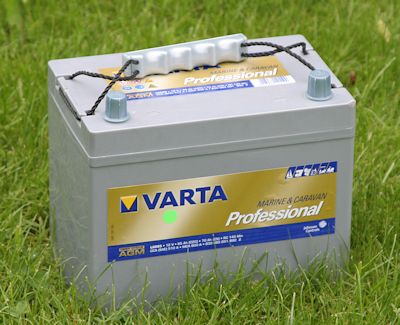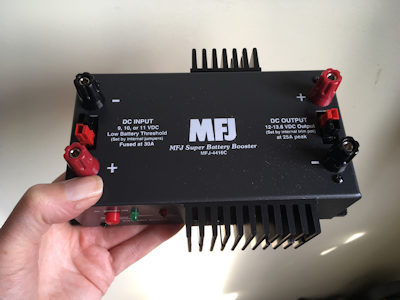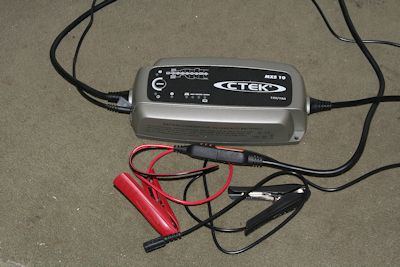Introduction
By the term "batteries for portable use" I am referring to using an external battery of around 12 Volts to power radio equipment while out portable using my car for both transport and shelter. While the obvious source of power would be the car battery itself, there are disadvantages to this approach, such as not being able to start the car if the battery becomes discharged and shortening the life of the battery.
My operating tends to involve running power levels in the 50 ~ 100 Watt range, plus a laptop powered from the battery. This is outings of 8 or more hours. For lower power demands, such as operating QRP from an FT817 or K1 without powering a laptop, the requirements are more easily met and will not be covered here.

Varta LAD85 Professional deep cycle AGM battery, part number 830085051
Step 1, how much power do we need?
I tend to be quite power hungry when out car portable, as in addition to a 100W transceiver, I usually use a laptop for both logging and DX cluster connection. The laptop is a Dell Vostro with a 16 inch screen, it is powered from 12 Volts via a 120 Watt inverter power supply which produces an output of 19.5 Volts. This particular supply will not charge the laptop battery as it is not a 3 pin type (Dell use a method of identifying the charger before the laptop will start charging).
The maximum supply current for a typical laptop that is able to charge from a 12 Volt adapter is roughly 5 Amps as measured on a 12 Volt variable Voltage bench power supply.
My most often used portable medium power transceiver used to be a Kenwood TS-480SAT, this transceiver produces around 85 ~ 90 Watts from a supply of 12.4 Volts, and an output of 65 Watts at 11 Volts, as measured at the power supply. The current drawn varies by band but the following measurements on 50.150 MHz will serve as a guide:
| Power level (as set) |
Power output |
Current drawn at 12.4V |
Notes |
| 100W |
88W |
16.5A |
|
| 75W |
75W |
15A |
|
| 50W |
52W |
12.5A |
|
| 25W |
26W |
9.2A |
|
| 10W |
11W |
7A |
|
| RX current |
n/a |
1A |
Varies slightly with backlight levels and volume |
If we plan for a reasonable scenario of 8 hours operating with 20% of that time spent in contact and 80% listening using SSB or CW. Also assume we are running near maximum power. The ARRL figures for RF exposure measurements suggest CW and speech processed SSB have a duty cycle of 40%, which putting all the above together give the following as a worked example:
Drawing the maximum key down current of 16.5A for 8 hours would equate to 132 Ampere Hours. We are only actively in QSO for 20% of that time and of that 20% we are only transmitting for half the time. Therefore we would use 13.2 Ah at 100% duty cycle or 5.3 Ah for 40% duty cycle modes, plus 0.8 Ah for the time on receive in that 20% QSO time.
For the rest of the time (80%) we are only listening, this is 6.4 hours out of our 8 hours on site, so add 7 Ah use (allowing a little extra for raised volume, etc).
The above figures are fairly rough but will be near enough given the variable nature of radio operating. This gives a quite reasonable 12.3 Ah use from the radio. Add the laptop and we need another 17 Ah (maybe slightly less if not charging the battery as well) making a total usage of 29.3 Ah over an 8 hour period. From my own measurements of remaining capacity in a battery, this figure is not far off the amount of power used. Obviously your operating and mine will be different, but it's not hard to arrive at a sensible figure.
Choice of battery size to supply the laptop and radio
If we were to use a lithium battery, the answer would be a battery not much larger than 30 Ah as they can stand deep discharge without loss of capacity. However at the present state of technology a lead acid battery is a more cost effective source of power for this application, although lithium iron phosphate batteries are gaining in popularity. The generally accepted rule is to not discharge a lead acid battery below about 50% if you want it to last. Manufacturers often quote a number of cycles down to 50% and also a lower number to 20% of remaining capacity. This figure does not take into account the additional factor of battery age and the Voltage discharge curve which is not flat for a lead acid type battery. A search of the internet will produce a number of well written articles covering the use of lead acid batteries, those by mpoweruk.com and batteryuniversity.com make good reading.
Taking the 50% discharge figure, it gives us a battery size of 70 Ah. A larger battery will maintain a higher Voltage for longer, but batteries of higher capacity than about 115 Ah tend to be too heavy for one person to carry.

The image above shows a pair of quick release battery clamps, which are widely available in the UK.
Choice of battery type
Not only do we have to consider the Amp hour rating of a battery, there are several varieties of lead acid battery too. The most common is the older style of car starter battery with the removable screw caps to top up the acid. In brief these are the available types of battery:
Flooded starter battery. These are not suitable for deep discharge, this is due to excessive erosion of the positive plate which is constructed from a sponge like lead in order to increase the surface area for high current capability. These batteries generally need a vent tube to remove explosive gasses during charging.
Traction battery. While a floor scrubber or golf cart battery may look like a useful battery for portable radio use, the plates are often made from lead-antimony to increase plate strength, however this has the disadvantage of increasing self discharge.
Leisure or marine battery. These are often a variation of the starter battery and may not be as well suited to regular deep discharge as their label may suggest. A 110Ah battery of this type had a measured capacity of only 33 Ah after a year of occasional use powering my portable radio equipment.
AGM deep cycle battery. The absorbed glass mat construction adds additional strength to a battery, in addition these batteries are sealed and re-absorb gasses produced during charging. The acid is safe from spillage even in the event of the battery case being broken. The "deep cycle" capability is created by using thick plates of lead-calcium, without the "sponge" of the starter battery type. The self discharge rate is around 1 - 2% per month for these types.
Gel cell. These are usually manufactured in smaller sizes for burglar alarm use and in larger sizes for UPS use. While possibly suited to our needs, they are not as robust with regard to charging as the AGM and can cost more.
Lithium iron phosphate. These batteries are available in 12 Volt versions up to around 100 Ah and are 2 or 3 times the cost of an AGM battery. The advantage is mainly one of weight and a more convenient Voltage than lithium ion types. Note they are not prone to bursting into flames like their lithium ion cousins and can be charged more easily.
The most suitable battery type in my opinion is a deep cycle AGM from a reputable manufacturer such as Varta. High grade AGM batteries cost around twice the price of similar looking generic leisure batteries but may last more than 3 times as long - more importantly they may also hold a higher Voltage level during discharge.
A Varta 85 Ah professional deep cycle AGM battery weighs 25 Kg, which is about as heavy a battery as I want to carry far. The "85 Ah" rating is for a discharge rate of C20, or 1/20th of the nominal capacity, ie. 4.25 Amp. The battery is rated for 107 Ah at C100 (850 mA) and 77 Ah at C10 (8.5 Amp) discharge.
Battery Voltage boosting

Since originally writing this page, I've added an MFJ-4416C Voltage Booster to my portable equipment. As the name suggests, this boosts the Voltage to 13.8 from the battery Voltage and is "keyed" to only run on TX by using the linear output key from the radio. This unit is invaluable when running radios that struggle on low Voltages, such as an Icom IC-9700 that I use on VHF/UHF. This MFJ unit is quite costly, but works well and by keying it using the linear key line, only runs on transmit and therefore doesn't producue any spurious signals from the inverter on receive. The additional current used by the booster is going to increase the drain on the battery, but as it's only running on TX and is a significant improvement on transmitterIMD performance, it's well worth using.
Battery charging

The old fashioned "car" battery charger and it's near equivalent automatic charger, often found in car accessory shops, is not a good choice to charge a high grade AGM battery. It is not even a good choice if you want maximum capacity and life from a low cost leisure battery.
My own comparison measurements between a simple two step automatic charger and a CTEK MXS10 charger show a significant improvement using the CTEK charger. The battery was a 5 year old Elecsol flooded plate battery, the battery was initially charged with the simpler charger, then discharged using a West Mountain Radio CBA II analyser. The battery was then charged with a CTEK charger and measured again. The improved performance was around 20%.
Unfortunately a CTEK charger costs more than twice the price of an ordinary automatic charger. The multi-stage charging process ensures the battery is thoroughly charged before indicating "green" after several hours of charge.
Conclusion
There is no such thing as a free lunch when it comes to the choice of a battery for medium power radio use, especially if you also intend to power a laptop. I haven't considered topping up the charge of a battery with a solar panel or wind turbine as that adds to the already significant expense. An alternative power source would of course be a small generator, these work well but may have higher running costs if you operate regularly and also are obviously noisier than using a battery.
A recent portable operating session of 7 hours dropped the battery Voltage to 12.5 Volts (off load). A measured re-charge used 0.4 KWh of electricity from the mains, at the present cost of off peak electricity in the UK this is around 6p, based on a worse case cost of 15p per KWh. This works out a lot cheaper than using a generator, although if you only operate once or twice a year the cost of a replacement battery becomes significant.
Logging with a pen and paper will significantly reduce your battery requirement. For my purposes running an ordinary Windows 11 SSD based laptop gives me access to software that suits my needs better than the lower power alternatives. I use Log4OM for general logging, Minos for logging RSGB VHF/UHF contests and Live MUF to view VHF band openings on a world map (it works via a cluster connection).


|
